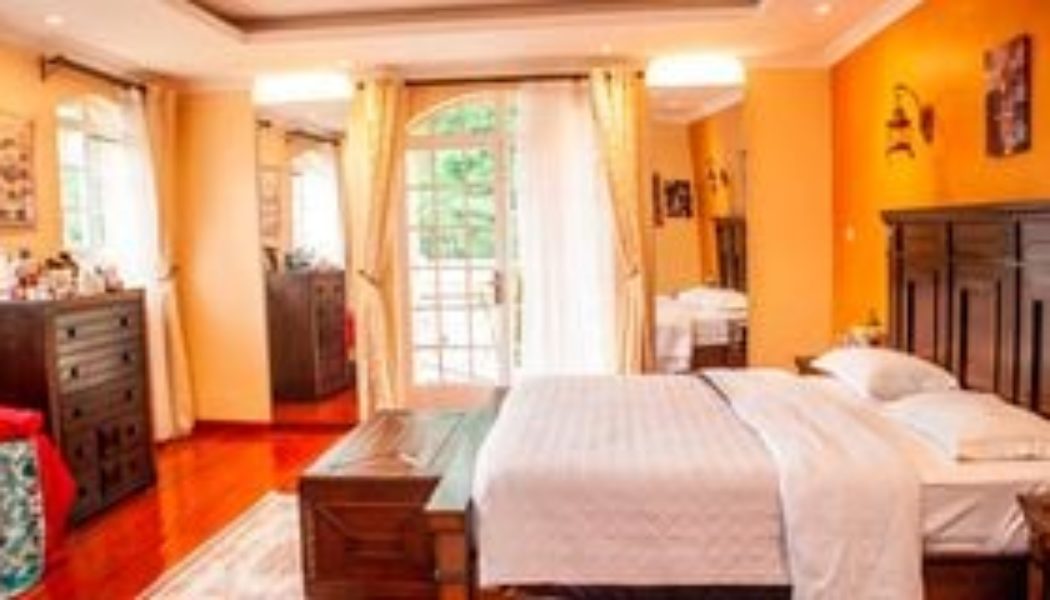At the heart of Kerarapon, Karen, sits Sia Sambeke’s five-bedroom house, which she constructed after years of pondering whether to buy or build.
“We moved here in 2021. Initially, we used to live in an apartment in Kilimani, and our family was growing.
“We did not want to be squeezed in one place. So, we decided to look for a home on the outskirts of Nairobi,” she says.
Working with a budget
Together with her husband, they started house hunting along Kiambu Road and fell in love with EdenVille estate, but the asking price was way beyond their budget.
“We were working with a budget of Sh20 million, and they were selling one unit at around Sh28 million.
“So, we went to Migaa Golf Estate. The houses there were within our budget, but the amenities were not easily accessible.
“So, we came looking at Kerarapon, settled to buy a 1/8th of an acre, and began constructing our dream home immediately,” she says.
The land cost them Sh7 million.
“When we came here, we had to come on a rainy day to see how the place looks during the rainy season.
“The good thing is that this place is up on a hill, so we don’t have flooding,” she says.
There was nothing too special about Kerarapon, she adds, but they liked that it was accessible to schools, a Catholic church, and shopping malls.
But like many homeowners, they exceeded their budget “We exceeded our working budget by about Sh2 million,” recalls Ms Sambeke.
At first, she wanted a small manageable place, but Kerarapon turned out better and bigger.
“I wanted a space where I could create a garden, parking for two cars, and three bedrooms, one for every child.
“I wanted a home where even without house help, I could still run it easily,” says the mother of three.
Construction of the home took seven months. They worked with experts, but she had her input, some of which was not actualised.
“When building the house, we worked with an architect, a structural engineer, the contractor, and I stood in as an interior decorator.
I preferred that the front of the house be raised, but I do not know what happened during the construction.
I told the architect that I wanted a door in the front that would be parallel to the back door so that if I closed my eyes, I could walk on a straight line,” the interior decorator tells the Business Daily.
She explains that an interior decorator comes in when the house is completely done and works on transforming the house into a home.
“People think that it is easy work, but it is not. You need to know where to place what and which colours would match,” she says.
When moving into her new home, Ms Sambeke opted to buy new things and sell or give out much of the house stuff she owned.
“I bought things an item at a time as I didn’t have the money to buy everything at a go.
“We started with the living room, bought the couches, and then bought the dining set.
“For the kitchen, I did not move in with many things apart from my crockeries and cutlery that I hold dear,” she says.
Colour coordination
When you get into Ms Sambeke’s home, you will notice the abundance of red colour in her home, with the red mats welcoming you and the red vases and pots spread across the whole house.
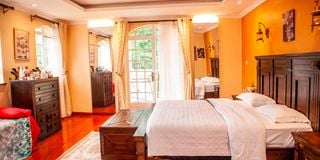
The master bedroom.
Photo credit: Billy Ogada| Nation Media Group
She says the most important thing she wanted to get right was the colour.
“Colour coordination can cheapen your home or make it vibrant. I did not want to do the all-white that is in many homes; I preferred light grey.
In the psychology of colours, when you do such a cool colour, something needs to bring it out.
So, I chose red because it is such a warm colour. Also, you cannot go wrong with red,” she says.
She says a beautiful home has nothing to do with how expensive the furnishings are.
“You do not have to put expensive stuff in your home to make it look good.
“What matters is how and where you put them,” says Ms Sambeke, who purchased most of her household goods from House of Leather.
Her love for art, particularly canvas, which has an African vibe, is evident.
She hangs many of her African art pieces in her pergola, which is her favourite part of her home.
“I have a bull horn that is painted with a Tanzanian flag on one horn and the Kenyan flag on the other side,” says Ms Sambeke, who was born and raised in Moshi, Tanzania.
The pergola is covered with polycarbonate sheets, and when the sun comes out, it gets very warm, so she covers the sheets with African lesos.
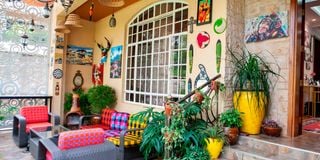
The pergola lounge area.
Photo credit: Billy Ogada| Nation Media Group
“The pergola is my safe place, my happy place. When I feel overwhelmed, I sit here, have coffee, watch the birds, breathe fresh air, and relax,” she says.
Her rustic staircase is one of the many treasures that she values most.
“It is just unique and beautiful. I also matched it with my foyer mirror and used the rustic decoration.
Why rustic? Metal will never run out, it is easy to maintain and safer,” she says.
Any foyer must have a console. A good console must hold a family photo, a plant, a candle, a basket, and preferably a book.
It is like a reception for your home. This is the place that guests see when they come into your home, so it has to look really nice.
She advises that you need to get it right when planting indoor plants.
“There are some indoor and outdoor plants. For indoor plants, the snake plant is an air purifier, and the peace lily is also a good indoor plant as it does not die quickly.”
Ms Sambeke is trying to redo her garden and is potting many of her palm trees. “I wish I had more space for my garden.
“I had planted my palms on the ground, but I saw they might destroy the perimeter wall, so I put them in pots. I want to have more colour in my garden.
“I want to do a lot of oranges, yellows, and reds,” she says as she appreciates her Zimbabwe grass, which she says is the easiest to grow, having been disappointed by the Kikuyu grass before.
The living room
Furniture was also important. “I wanted antique furniture, but it was very expensive, so I worked with what I could afford at the time.
“A good buffet table would have gone for around Sh150,000. That was not a priority at that time.”
She has two dining sets. “I put a second dining set because I have small children. They can always be served from here.” Every bit of her wall has something, either family portraits, art pieces, or her children’s drawings.
Her kitchen is black and white with a sliding pantry area. “I was very intentional about having a black and white kitchen, as they are neutral and earthly colours that you can never go wrong with.
“I wanted sliding pantry doors because a swinging door takes up a lot of space.”
The living room is the only part of her home where red is not pronounced.
It maintains a chilled vibe with the white mat, the green-coloured curtains, and the brown suede seat. She also has a wooden floor, which she says is much warmer.
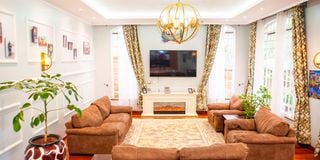
Sia Sambeke’s living room
Photo credit: Billy Ogada| Nation Media Group
“Initially, we had laminate flooring, but the laminates kept coming out, so we settled for this wooden floor.
Getting suitable curtains to match grey is difficult; I even think I should get white curtains.”
She has shied away from the traditional hearth and opted for an electric fireplace. “I did not want my home to always bear the smell of smoke,” she says.
She also opted for floor-to-ceiling windows to get enough light and fresh air in the house. “Lighting for me is very important,” she says.
So, apart from the brass chandeliers, she has downlighters spread across her home.
The cost
Ms Sambeke estimates the total cost of designing her home at around Sh1.5 million.
“For the pots and the plants, it cost me around Sh500,000. The living room has taken up roughly Sh1 million, with the couches going for Sh550,000,” the 36-year-old says.
Ms Sambeke adds that, in her experience, it is best to build your own home, as “you get to build it as you would want it to look.
“When you buy a home, there is so much you cannot do, especially if you take a mortgage. You are limited in terms of the changes you can bring to the house until you clear the mortgage.”
In addition, you may move in and still want to make some changes. “For instance, in this home, I have put two wooden room dividers between the kitchen and the dining area.
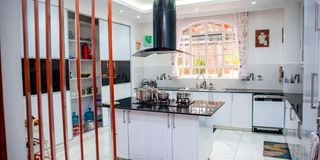
Sia Sambeke’s kitchen
Photo credit: Billy Ogada| Nation Media Group
“Initially, it had a kitchen island, and I didn’t want it because I felt that it was a cliché. So I brought it down and put the room dividers, ” says Ms Sambeke, adding that, being an interior designer, she felt pressured to create a good home.
“I am an interior decorator, and when someone walks into my house, that fact has to be reflected.”
